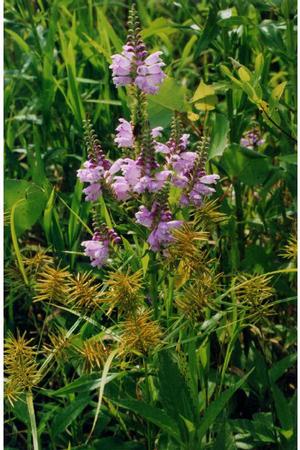Printed at http://www.newmoonnursery.com/index.cfm/

Obedient plant spreads by rhizomes and forms colonies, an attractive soil stabilizer. Jennifer Anderson @ USDA-NRCS PLANTS Database
Physostegia virginiana
Obedient plant
Native to North America
FIRST IMPRESSIONS: Physostegia virginiana is a robust perennial wildflower with bold lance shaped leaves. In late summer and early fall, foliage is topped by graceful lavender, pinkish or white spikey inflorescences. The individual florets are tubular and similar to snapdragons. Plants thrive in prairie type settings or sunny gardens with average well drained soil.
HABITAT & HARDINESS: Physostegia virginiana occurs through eastern North America west to Manitoba, North Dakota and Texas.
This species is indigenous to moist or mesic Blackland prairies, limestone glades, woodland edges, moist meadows, thickets, seeps and moist roadside or railroad right-of-ways.
Plants are hardy from USDA Zones 3-9.
PLANT DESCRIPTION: Physostegia virginiana is an erect tap-rooted perennial with sturdy unbranched square stems.
Leaves are lance shaped with widely spaced pointed teeth. Blades are about 5” long and 1½” wide. They are sessile with rounded bases and pointed tips.
The stems terminate in showy 10” spike-like flower racemes. Four rows of densely packed florets open from the bottom of the raceme to the top. Tubular florets appear at the bottom of the stalk with pearl-like flower buds above and the youngest green buds at the tip.
The florets are tubular and about 1” long with a broad upper lip and a 3 lobed lower lip. They are pink, lavender or white in late summer for about 6 weeks and are marked with purple stripes or dots.
After pollination, the calyx inflates to hold brown sharply angled seed.
Plants grow 3-4’ tall and spread to 2-3’ spread or more by rhizomes.
CULTURAL & MAINTENANCE NEEDS: Physostegia virginiana flourishes in sun or part sun with moist or average soil. Plants tolerate clay loam, sandy loam, gravelly soil, alkaline or acid pH, heat and some drought.
Many consider this species to be invasive. It is more likely to grow aggressively in moist rich soil. If exposure is shaded, plants are likely to flop.
During drought, the lower leaves may turn yellow and defoliate. Plants are generally pest resistant and are not palatable to deer.
LANDSCAPE USES: This is a good choice for a Wildlife Garden or sunny Meadow. Plants are also used as Cut Flowers or as part of a Grouping or Mass Planting. Physostegia virginiana has Showy Blooms and is appropriate for Cottage Gardens, Low Maintenance Plantings, Rain Gardens and Perennial Borders.
COMPANION & UNDERSTUDY PLANTS: Try pairing Physostegia virginiana with Asclepias tuberosa, Amsonia tabernaemontana, Carex bicknellii, Echinacea purpurea, Panicum virgatum, Rudbeckia subtomentosa, Schizachyrium scoparium or Sorghastrum nutans.
Physostgia virginiana ‘Vivid’ has similar appearance and culture and could be substituted in some garden situations.
TRIVIA: Flowers are generally pollinated by bumblebees. Other long tongued bees, hummingbirds and the occasional butterfly also sip nectar.
Due to the showy flowers, this species was introduced into gardens early on. Nursery selections are usually pink but wild populations are often white.
The common name “obedient plant” was bestowed because individual florets stay in place (at least temporarily) after being repositioned. This species is sometimes called false dragonhead due to the flower’s resemblance to dragonhead (Dracocephalum spp.)
This plant is a member of the Mint Family. The word Physostegia is from the Greek words physa meaning “bladder” and stege meaning “roof covering”. This name refers to the inflated calyx that covers or encloses the seed.
Height:
3-4 ftSpread:
2-3 ftUSDA Hardiness Zone:
3-9Bloom Color:
PinkPhysostegia virginiana Characteristics
Attracts Wildlife
- Butterflies
- Pollinators
- Hummingbirds
Attributes
- Rain Garden
- East-Coast Native
- Cut Flower
- Clay Soil
- Bog
- Naturalizing
- Long Blooming
- Favorite
Exposure
- Full Sun to Partial Shade
Deer Resistant
- Deer Resistant
Flowering Months
- September
- August
Foliage Color
- Green
Growth Rate
- Fast
Juglans nigra Tolerance (Black Walnut)
- Yes
Salt Tolerance
- Medium
Season of Interest (Foliage)
- Summer
- Spring
Soil Moisture Preference
- Dry to Moist
Interesting Notes:
For more information on this plant, visit the USDA PLANTS Database: http://plants.usda.gov/java/profile?symbol=PHVI8
